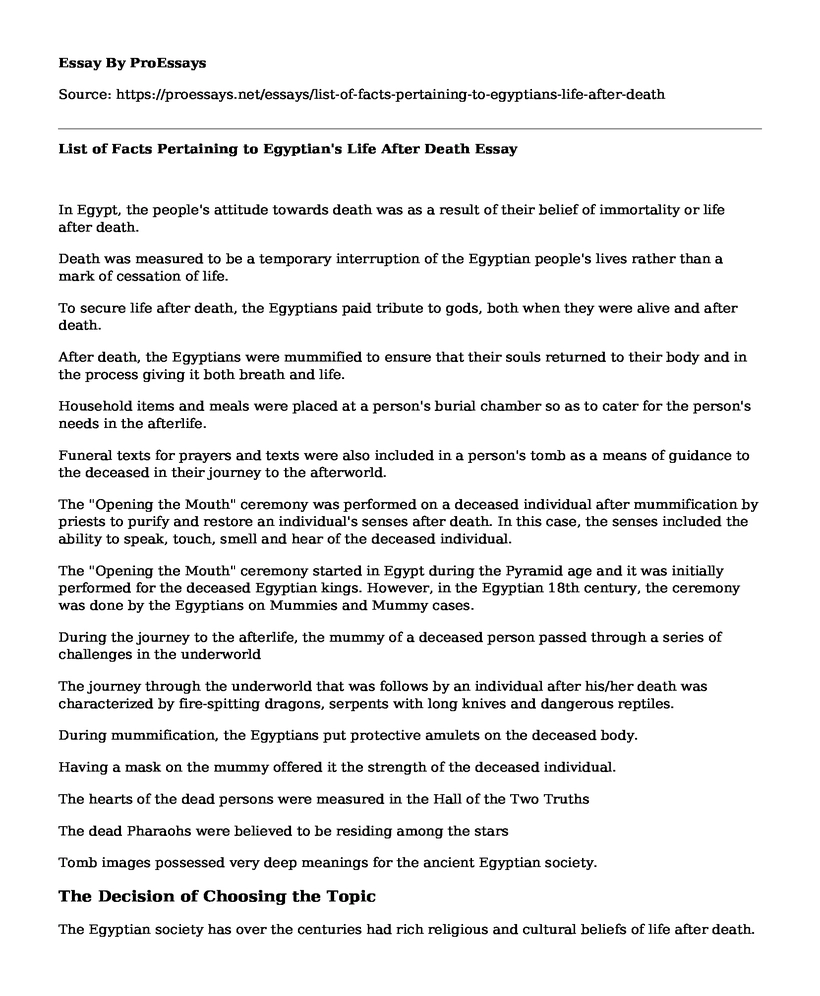In Egypt, the people's attitude towards death was as a result of their belief of immortality or life after death.
Death was measured to be a temporary interruption of the Egyptian people's lives rather than a mark of cessation of life.
To secure life after death, the Egyptians paid tribute to gods, both when they were alive and after death.
After death, the Egyptians were mummified to ensure that their souls returned to their body and in the process giving it both breath and life.
Household items and meals were placed at a person's burial chamber so as to cater for the person's needs in the afterlife.
Funeral texts for prayers and texts were also included in a person's tomb as a means of guidance to the deceased in their journey to the afterworld.
The "Opening the Mouth" ceremony was performed on a deceased individual after mummification by priests to purify and restore an individual's senses after death. In this case, the senses included the ability to speak, touch, smell and hear of the deceased individual.
The "Opening the Mouth" ceremony started in Egypt during the Pyramid age and it was initially performed for the deceased Egyptian kings. However, in the Egyptian 18th century, the ceremony was done by the Egyptians on Mummies and Mummy cases.
During the journey to the afterlife, the mummy of a deceased person passed through a series of challenges in the underworld
The journey through the underworld that was follows by an individual after his/her death was characterized by fire-spitting dragons, serpents with long knives and dangerous reptiles.
During mummification, the Egyptians put protective amulets on the deceased body.
Having a mask on the mummy offered it the strength of the deceased individual.
The hearts of the dead persons were measured in the Hall of the Two Truths
The dead Pharaohs were believed to be residing among the stars
Tomb images possessed very deep meanings for the ancient Egyptian society.
The Decision of Choosing the Topic
The Egyptian society has over the centuries had rich religious and cultural beliefs of life after death. Additionally, this phenomenon was marked by the numerous cultural and religious practices that were executed by the Egyptians both in life and after death. In this context, the selection of the topic will seek to determine the cultural and religious practices that influenced the Egyptians' beliefs of life after death. Moreover, the topic will also help in the formulation of a comprehensive research focusing on 10 factual data pertaining the Egyptian's society in reference to life after death.
Annotated Bibliography
Canadian Museum of History. (2018). Mysteries of Egypt. Retrieved from Canadian Museum of History: https://www.historymuseum.ca/cmc/exhibitions/civil/egypt/egypte.shtml#menu
The website is owned, authored and maintained by the Canadian Museum of History (2018). Additionally, the online publication will be a key resource in understanding as well as learning the various key facts that formed the ancient Egyptian's beliefs of life after death. Ultimately, the online publication will be an essential resource that will be employed to expound the topic of this research in order to offer the targeted audience vast information on the Egyptian history in relation to life after death.
IP Factly. (2015). Ancient Egypt Afterlife Beliefs. Retrieved from IP Factly: http://ipfactly.com/ancient-egypt-afterlife-beliefs/
The online article was published by IP Factly (2015) and it also addresses the topic of ancient Egyptian afterlife beliefs. Additionally, the publication discusses nine key facts that characterized the Egyptian's life after death. Ultimately, this publication will also be essential in advancing the focus of this research that seeks to ascertain the factors that influenced the occurrence of various beliefs of the ancient Egyptian people in reference to life after death.
Fleming, F., & Lothian, A. (2011). Ancient Egypt's Myths and Beliefs. New York: The Rosen Publishing Group.
The publication was authored by Fleming and Lothian (2011) and it largely focused on the discussion of ancient Egyptian myths as well as beliefs. Additionally, this publication will be essential in advancing the research of this project because it will discuss how the ancient Egyptians had a strong belief in numerous gods as well as in life after death. Ultimately, the publication will also be essential in supporting the knowledge of different facts of the ancient Egyptian society in reference to life after death as stipulated by the other publications used in the analysis of the research.
References
Canadian Museum of History. (2018). Mysteries of Egypt. Retrieved from Canadian Museum of History: https://www.historymuseum.ca/cmc/exhibitions/civil/egypt/egypte.shtml#menu
Fleming, F., & Lothian, A. (2011). Ancient Egypt's Myths and Beliefs. New York: The Rosen Publishing Group.
IP Factly. (2015). Ancient Egypt Afterlife Beliefs. Retrieved from IP Factly: http://ipfactly.com/ancient-egypt-afterlife-beliefs/
Cite this page
List of Facts Pertaining to Egyptian's Life After Death. (2022, May 26). Retrieved from https://proessays.net/essays/list-of-facts-pertaining-to-egyptians-life-after-death
If you are the original author of this essay and no longer wish to have it published on the ProEssays website, please click below to request its removal:
- John Adams and Thomas Jefferson Essay
- Ways to Expand the Current Research Project on Holocaust
- Research Paper on Kamikazes In The World War 2
- Essay Sample on Industrial Revolution: Impact on Modern Society
- Essay on Hitler's Appointment: The Dawn of Non-Democratic Rule in Germany
- Essay Example on Heroic WWI Soldiers Recognized: Pvt. Johnson & Sgt. Shemin
- Essay Example on Reconstruction of Destroyed Infrastructure: Challenges & Considerations







